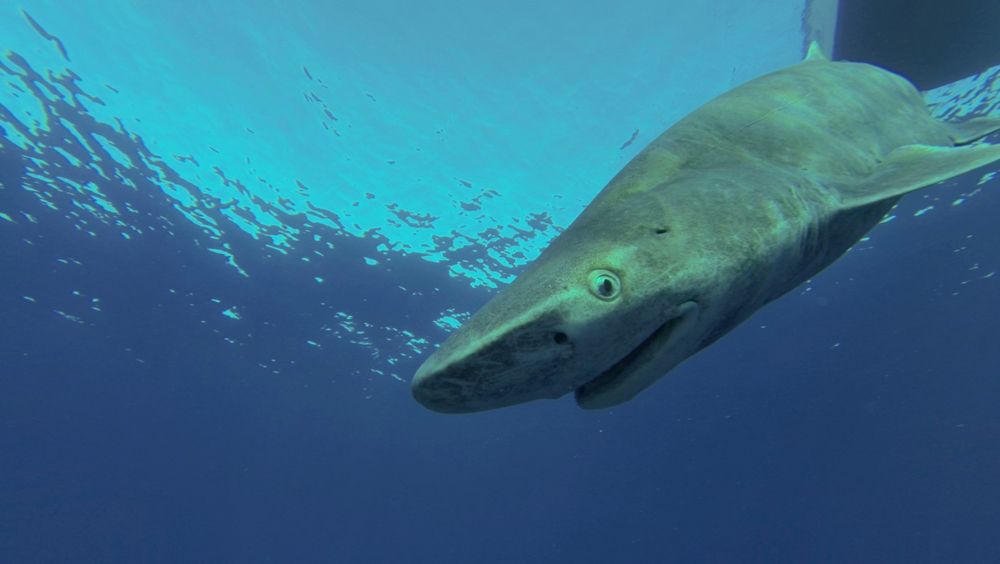Shark-Mounted Cameras Reveal Predators' Deep-Sea Secrets

In a first-of-its-kind project using cameras mounted onto the fins of deep-sea sharks, researchers have made surprising discoveries about what keeps these mysterious creatures afloat.
Previously, scientists assumed that sharks were negatively buoyant (meaning they have a natural tendency to sink) or neutrally buoyant (meaning their buoyancy is canceled out by their weight in the water). Now, by combing through photos and data captured by the swimming sharks, researchers have found that two species of these deep-sea creatures — sixgill and prickly sharks — have a small amount of positive buoyancy that pushes them toward the surface.
Scientists at the University of Hawaii and the University of Tokyo attached a flashlight-size camera to deep-sea sharks to study their swimming habits. The camera works at depths of up to 6,500 feet (2,000 meters), and can be paired with a strobe that provides light to take pictures in dark, deep waters. [See photos of the deep-sea sharks with fin-mounted cameras]
Every 30 seconds, the strobe would illuminate the shark's surroundings and the camera would snap a picture, while sensors recorded the depth and temperature of the water. The scientists also included an accelerometer and magnetometer in the camera pack, on a small metal band fastened to the shark’s fin.
"We set a date and time we want it to come off, the metal band breaks and drops off the shark and the package floats up to the surface of the ocean [and] sends us a satellite sign of where it is," said study co-author Carl Meyer, an assistant researcher at the University of Hawaii at Manoa's Hawaii Institute of Marine Biology.
The results of the deep-sea investigation were surprising, according to the researchers. "It was not at all what we expected to find," Meyer said. "Conventional wisdom suggests sharks are generally negatively buoyant — they'll sink if they stop swimming."
Though there has been some research suggesting that sharks have some neutral buoyancy, there was no reason for Meyer and his colleagues to expect that sharks actually float up.
Sign up for the Live Science daily newsletter now
Get the world’s most fascinating discoveries delivered straight to your inbox.
Meyer was initially so puzzled by the finding that he wondered if the equipment package could be changing the shark's buoyancy. But after re-calibrating and repeating the experiment, the results stood firm, he said.
The scientists can tell that the sharks were using energy to muscle downward from data recorded by the accelerometer and by the frequency of the sharks' tail movements. "What we saw by comparing uphill and downhill movements, among all the individuals tested, the tail was working harder at any given speed than when they were going up," Meyer said. "When they were going uphill, they could glide for minutes at a time without beating their tails." [8 Weird Facts About Sharks]
Figuring out why it's beneficial for sharks to be buoyant — and how many species have this trait — will take more work, the researchers said.
Meyer wonders if positive buoyancy is widespread in deep-sea organisms, to help animals survive and exploit a challenging habitat. "The deep sea is dark and cold, with low oxygen and limited food resources," he said. "There may be that something about being positively buoyant allows you to go down into very unfavorable locations, and still make it back up to where it's warmer."
The sharks studied in Hawaii make a daily migration: After spending their days at depths of more than than 2,000 feet (610 m), they head up around sunset to a depth ranging from about 600 to 1,000 feet (183 to 305 m), where the water temperatures are around 60 degrees Fahrenheit (16 degrees Celsius).
The reason for this daily trek is a subject of debate, Meyer said. "There are a number of papers suggesting that sharks either hunt warm and rest cool, or hunt warm and rest warmer," he said. "Food and sleeping spots aren't the same places."
Moving between ocean depths could help sharks digest and process their meals, Meyer said. "You go up to catch stuff, and then the colder area lets your digestion suck up the nutrient," he added.
Additional studies with fin-mounted cameras may help the researchers peek into sharks' other habits. For example, the sharks may just be following prey up and down the water column. The scientists are also eager to learn whether the sharks’ activity rates — how much the animals move around — change as a function of core muscle temperature.
Meyer pointed to the need to dig a lot deeper into the mysterious lives of fish that creep in the deep: "Finding positive buoyancy in [deep-sea] sharks is demonstrative that we have a lot to learn about deep-sea animals and how they survive."
The detailed findings of the study were published June 10 in the journal PLOS ONE.
Follow us @livescience, Facebook & Google+. Original article on Live Science.












